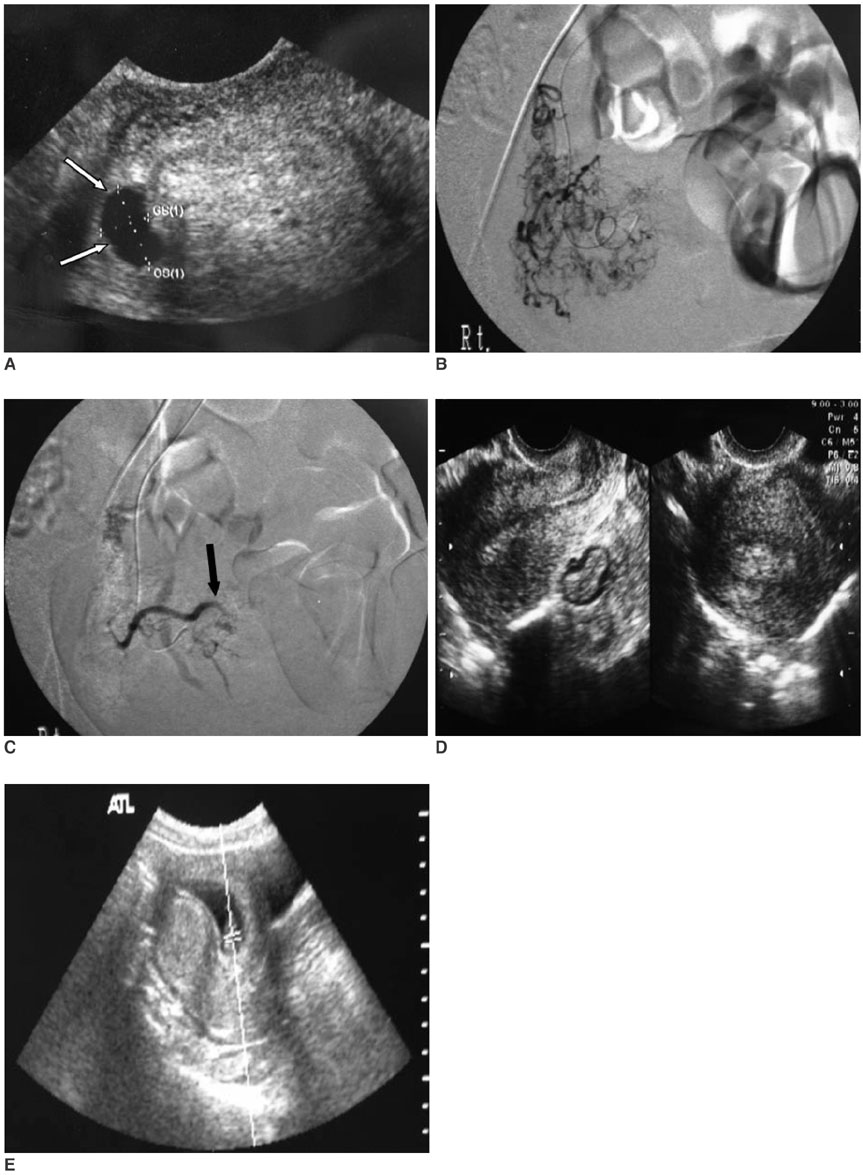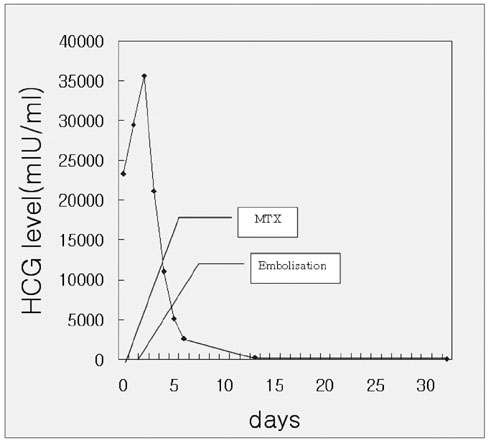Korean J Radiol.
2007 Apr;8(2):176-179. 10.3348/kjr.2007.8.2.176.
Selective Uterine Artery Embolization for Management of Interstitial Ectopic Pregnancy
- Affiliations
-
- 1Department of Radiology, Soonchunhyang University Gumi Hospital, Gumi, Korea. ysbysb@sch.ac.kr
- 2Department of Obstetrics and Gynecology, Soonchunhyang University Gumi Hospital, Gumi, Korea.
- 3Department of Radiology, Soonchunhyang University Hospital, Seoul, Korea.
- 4Department of Radiology, Chosun University Hospital, Gwangju, Korea.
- KMID: 1126843
- DOI: http://doi.org/10.3348/kjr.2007.8.2.176
Abstract
- Interstitial ectopic pregnancy is a rare condition of pregnancy and may be very dangerous if not identified and treated urgently. We report a case of successful treatment of an interstitial pregnancy using selective uterine artery embolization. A 27-year-old woman with interstitial pregnancy was treated by uterine artery embolization after failure of systemic methotrexate treatment. Her serum beta-human chorionic gonadotropin (β-hCG) was undetectable one month after the therapeutic embolization and transvaginal sonography 31 days after embolization showed normal endometrium and cornu. The patient achieved a normal pregnancy eight months after embolization.
MeSH Terms
Figure
Reference
-
1. Rock JA, Damario MA. Rock JA, Thompson JD, editors. Ectopic pregnancy. TeLinde's operative gynecology. 1997. 8th ed. Philadelphia: Lippincott-Raven;505–520.2. Oelsner G, Admon D, Shalev E, Shalev Y, Kukia E, Mashiach S. A new approach for the treatment of interstitial pregnancy. Fertil Steril. 1993. 59:924–925.3. Advincula AP, Senapati S. Interstitial pregnancy. Fertil Steril. 2004. 82:1660–1661.4. Zhang X, Liu X, Fan H. Interstitial pregnancy and transcervical curettage. Obstet Gynecol. 2004. 104:1193–1195.5. Katz DL, Barrett JP, Sanfilippo JS, Badway DM. Combined hysteroscopy and laparoscopy in treatment of interstitial pregnancy. Am J Obstet Gynecol. 2003. 188:1113–1114.6. Ophir E, Singer-Jordan J, Oettinger M, Odeh M, Tendler R, Feldman Y, et al. Uterine artery embolization for management of interstitial twin ectopic pregnancy: case report. Hum Reprod. 2004. 19:1774–1777.7. Deruelle P, Lucot JP, Lions C, Robert Y. Management of interstitial pregnancy using selective uterine artery embolization. Obstet Gynecol. 2005. 106:1165–1167.8. Walker WJ, Pelage JP. Uterine artery embolisation for symptomatic fibroids: clinical results in 400 women with imaging follow up. BJOG. 2002. 109:1262–1272.9. Deruelle P, Closset E. Management of interstitial pregnancy using selective uterine artery embolization. Obstet Gynecol. 2006. 107:427–428.10. Tropeano G, Di Stasi C, Litwicka K, Romano D, Draisci G, Mancuso S. Uterine artery embolization for fibroids does not have adverse effects on ovarian reserve in regularly clycling women younger than 40 years. Fertil Steril. 2004. 81:1055–1061.
- Full Text Links
- Actions
-
Cited
- CITED
-
- Close
- Share
- Similar articles
-
- A case of conservative management of cervical pregnancy using selective uterine artery embolization
- Successful management of cesarean scar pregnancy at 13 weeks of gestation by uterine artery embolization: A case report
- Laparoscopic uterine artery occlusion before cervical curettage in cervical ectopic pregnancy: Safe and effective for preventing massive bleeding
- Uterine necrosis after partial obstruction of the uterine artery via selective embolization in postpartum hemorrhage: A case report
- Conservative management of placenta increta treated with selective uterine artery embolization: Review of two cases



